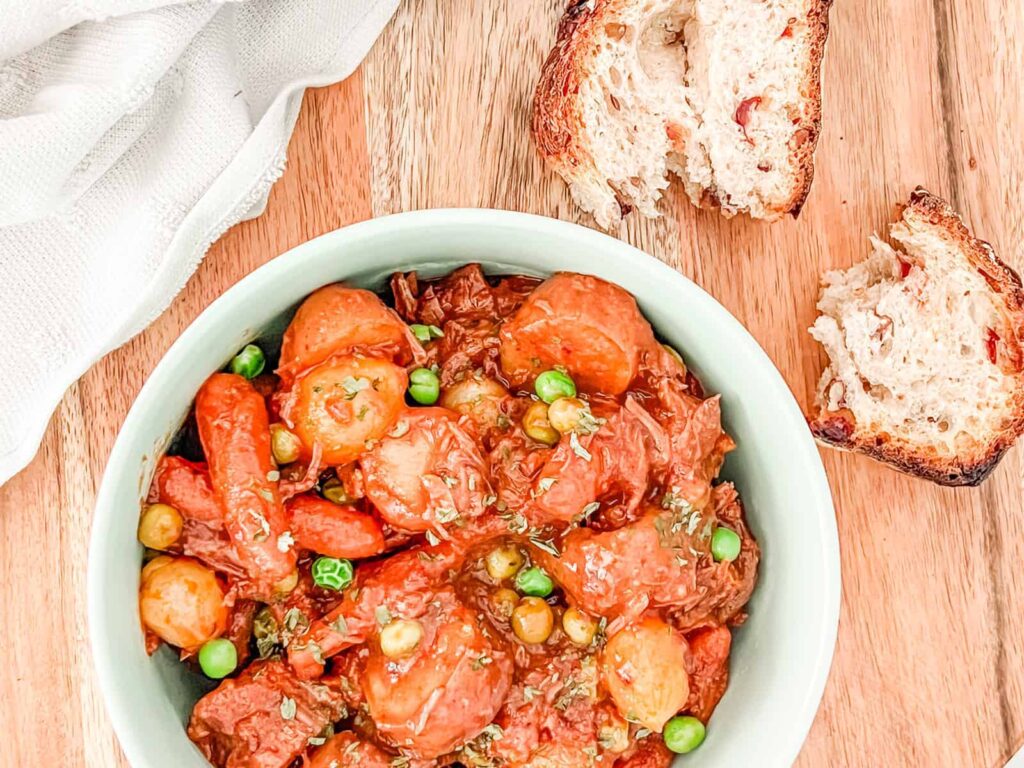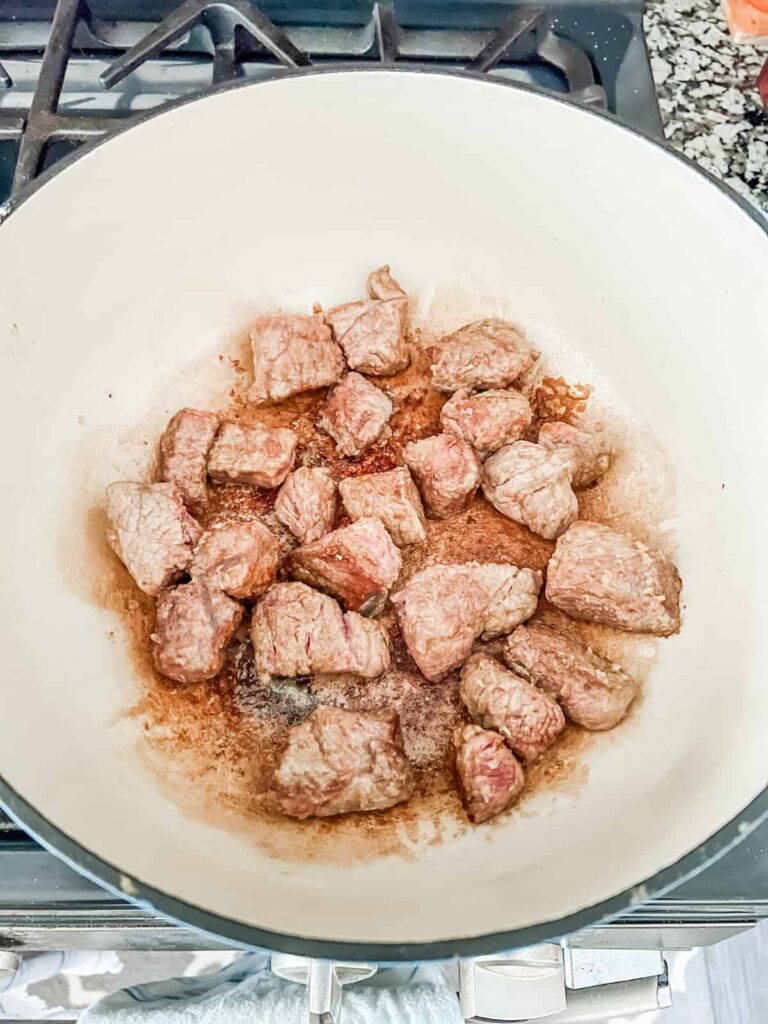The 4 Best Beef Stew Wine Pairings (Expert Picks)
Are you in search of the best beef stew wine pairing? Well, you’ve landed in the right place.
This dish is classic comfort food, with its chunks of tender beef and a medley of vegetables simmered to perfection. And paired with the right wine, it can go from good to gourmet.
Now, not all wines are created equal when it comes to pairing with beef stew. But I’m here to help. As a WSET-certified wine expert (and beef stew lover), I’ve tested the combos. And I put together this guide that’ll take your next beef stew meal up a notch.
Plus, I’m sharing my favorite beef stew recipe. It’s of course simmered with a generous pour of red wine!

Pairing Wine with Beef Stew
Traditional beef stew is one of my favorite comfort foods. The slow-cooked meat is simmered with veggies like carrots, potatoes, and pearl onions in an herby, red-wine-infused beef broth.
Beef stew’s bold flavors should be paired with a wine that won’t be easily overpowered. The intensity of both the stew and wine need to be matched. That’s why you’ll want a full-bodied wine.
The salty notes in this dish will tone down any astringency and bitterness in the wine, letting the fruit flavors shine. Plus, tannins bind to meat proteins, further softening the wine. So, don’t hold back on choosing a higher tannin wine for your pairing selection.
Oh, and the fat from the beef needs a wine with good acidity to balance it out. Especially, if your stew has tomatoes. Otherwise, the tannins will clash with the tomatoes and leave a metallic taste in your mouth.
The Best Beef Stew Wine Pairing
The best beef stew wine pairing is a dry, full-bodied red wine with good acidity. Top choices include Bordeaux-style blends, Nebbiolo, Cabernet Sauvignon, and Syrah. But there are many similar wines that will work just as well.
I wouldn’t recommend pairing a white wine with beef stew. It will likely be overpowered by the rich flavors. But if you aren’t into red, you could go for a full-bodied wine like oaked Chardonnay.
Below, I’m breaking down why these wines work and where to find them.

Bordeaux
This region in Southwest France is known for producing some of the world’s best red wine. These are almost always a blend of several grape varieties. When it comes to beef stew’s bold flavors, a Left Bank Bordeaux is the way to go.
These wines are mainly Cabernet-Sauvignon-based. But they can include Cabernet Franc, Merlot, Petit Verdot, Malbec, and Carménère in the blend.
They’ll be fuller in body and have higher tannins than the softer Merlot-based Right Bank styles. And the flavors of blackcurrant, black cherry, and dried herbs work well with this herb-seasoned stew. It’s also a great wine pairing for the classic French dish beef bourguignon, made with red Burgundy.
Look for these wines from the Haut-Médoc or Graves appellations. The best way to get the most bang for your buck is to buy a good vintage. In the best years, even the less-expensive Bordeaux blends are great quality. For recent vintages, keep an eye out for 2020, 2019, 2016, and 2015.
🍷 Similar Wines: Super Tuscans (Bolgheri region in Italy), Meritage or Claret (U.S. Bordeaux-style blends)
Nebbiolo
At first glance, you might mistake Nebbiolo for Pinot Noir with its pale garnet color. But one sip and you’ll know it’s an entirely different grape.
It comes with a full body, high tannins, and sharp acidity. That makes it an excellent choice for hearty beef stew, especially ones with tomatoes.
This grape produces wines with flavors of red fruits like raspberry and cherry. And it’s often identified by its signature aroma, described as “tar and roses.”
Nebbiolo’s home is in the Piedmont region of Italy. Here, Barolo gets the spotlight. At 100% Nebbiolo, it often needs years to mellow out its harsh tannins.
But if you can’t afford an aged Barolo, the salt and fat in beef stew make a young Barolo more approachable. Or go for its more fruit-forward sibling, Barbaresco.
And if Barolo and Barbaresco are beyond your budget, try a Langhe Nebbiolo. These can still offer great quality without emptying your wallet.
🍷 Similar Wines: Aglianico, Sangiovese, Xinomavro

Cabernet Sauvignon
The world’s most widely planted wine grape is a classic pairing with beef. And it’s a great match for this delicious dish.
Cabernet Sauvignon brings enough body to match the intensity of beef stew. Its typically high tannins are softened by the fatty red meat, enhancing the fruity flavors. And the medium to high acidity keeps things fresh.
You’ll find dark fruit flavors like blackberry, black plum, and blackcurrant. Plus, baking spices like nutmeg and clove.
This grape variety is grown throughout the world. Single varietal versions are most famous from California in the United States. But you’ll find it anywhere from Spain to Australia to South America to South Africa.
🍷 Similar Wines: Cabernet Franc, Touriga Nacional, Carménère, Malbec
Syrah
Syrah, or Shiraz as it’s known Down Under, pairs well with beef stew because of its bold flavors and full body, which match the heartiness of the dish. The black pepper, spice, and sometimes smoky notes of Syrah play well with the stew’s savory goodness.
Though they come from the same grape variety, Syrah and Shiraz can be very different wines. The better pairing depends on your personal preference and the type of beef stew.
French-style Syrah brings an elegant, earthy flavor with higher acidity and lower tannins. If your stew is more subtly flavored, this style can make a good match. Syrah’s home is the Northern Rhône region, but you’ll also find this grape used in GSM blends (Grenache, Syrah, Mourvèdre) in the Southern Rhône.
On the flip side, if your beef stew is rich and robust, Australian Shiraz is a great pairing. This bold red wine is usually fruitier with higher tannins, which can hold up to more intense stews. You’ll find these from regions like Barossa Valley, Hunter Valley, and McLaren Vale.
🍷 Similar Wines: Petite Sirah, Petit Verdot, Mourvèdre (aka Monastrell or Mataro)
Does Merlot Go With Beef Stew?
Yes, Merlot can be a good match for beef stew. Especially if you prefer lower tannin wines. The fruity and sometimes herbal and spiced notes in Merlot can add an extra layer of complexity to the meal. Go for a fuller-bodied style to make sure it can handle the richer flavor of this dish.
Best Wine for Cooking Beef Stew

The best wine for cooking beef stew is a dry red wine. It will bring out the rich, savory goodness of the meat while adding a layer of complex flavors.
Cabernet Sauvignon or Merlot are both great options that are readily available. And Pinot Noir is the classic choice for beef bourguignon. But really, most dry red wines will work. You can even cook the stew with the same wine you plan to pair it with.
Oh, and quality is key! A quick rule of thumb is if you’d enjoy drinking it, it’s a good choice for your stew.
What to Serve with Beef Stew

A hearty bowl of stew can stand alone as a meal. But the right sidekicks can take it to a new level of deliciousness.
Here are some of my favorite sides to serve with beef stew:
- Crusty Bread: Perfect for soaking up every last drop of that rich, savory broth.
- Mashed Potatoes: This creamy, velvety concoction acts as a bed for beef stew. Or go with cauliflower mash for a lighter alternative.
- Fresh Salad: Balance the richness of the stew with a simple green salad.
- Rice: Soak up the stew’s flavors while adding a different texture to the mix.
- Polenta: A comforting corn-based choice that pairs brilliantly with beef stew.
- Egg Noodles: The delightful chewiness makes your meal more satisfying.
- Biscuits: Use this light and fluffy treat to soak up the savory stew juices.
- Steamed Vegetables: Add a nice crunch and a burst of color to your meal.
- Roasted Garlic Bread: The pungent flavors and crispy texture make a great addition to your meal.
- Cheese Platter: You can’t go wrong with a selection of cheeses with some crackers. Or even a small charcuterie board. Plus, it goes great with the wine!
Looking for more dinner ideas and wine pairings? Check out filet mignon wine pairings, pork chop wine pairings, bolognese wine pairings, and chicken marsala wine pairings.
Beef Stew Recipe Equipment



For this recipe, you’ll need the following equipment:
- Large Dutch oven or slow cooker
- Chef’s knife – this is my go-to set
- Kitchen tongs
Recommendations may be affiliate links on which I earn a small commission at no additional cost to you. This helps me share new wine destinations with you and I only recommend products and services that I love and think you’ll love too!

Beef Stew Recipe
Ingredients
- 3 cups flour
- 2.5 lbs beef stew meat
- 4 tbls olive oil
- 1 lb baby carrots
- 10 small red bliss potatoes (quartered)
- 3 cloves garlic, minced
- 1/2 lb pearl onions (fresh or frozen)
- 4 cups beef stock
- 2 cups crushed tomatoes
- 2 cups dry red wine
- 1 tblsp dried basil
- 2 bay leaves
- 1 cup frozen peas
- salt and pepper to taste
Instructions
- Season the flour with salt and pepper. Coat beef with the flour.
- Add oil to Dutch oven and heat on medium-high. Brown meat on all sides and set aside. You may need to do this in batches.
- Add carrots, potatoes, and garlic to Dutch oven. If using fresh onions, add those as well. Cook on medium-high heat for 5 minutes, stirring occasionally.
- Add meat, tomatoes, basil, bay leaves, beef stock, and 1 cup of wine.
- Cover and simmer on the stove for 1 hour.
- Add remaining 1 cup of wine. Simmer for 3 more hours, covered.
- Remove bay leaves. Add frozen peas and frozen onions (if using). Add salt and pepper to taste.







